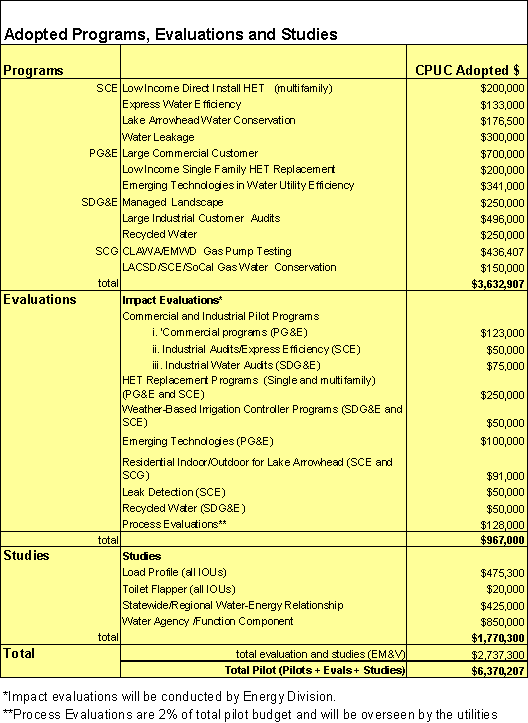ALJ/SAW/jt2 Date of Issuance 12/21/2007
Decision 07-12-050 December 20, 2007
BEFORE THE PUBLIC UTILITIES COMMISSION OF THE STATE OF CALIFORNIA
Southern California Edison Company's Application For Approval of Embedded Energy Efficiency Pilot Programs for 2007-2008. |
Application 07-01-024 (Filed January 16, 2007) |
And Related Matters. |
Application 07-01-026 Application 07-01-029 Application 07-01-030 (Filed January 16, 2007) |
ORDER APPROVING PILOT WATER CONSERVATION PROGRAMS WITHIN THE ENERGY UTILITIES' ENERGY EFFICIENCY PROGRAMS
Title Page
3. The Proposed Pilot Programs 1313
3.1.1. Industrial Process Improvement in the Food Processing
Sector- $285,980 1313
3.1.2. Industrial Process Improvement in the Winery
Sector - $158,698 1414
3.1.3. Ozone Laundry Treatment in the Hospitality
Sector - $216,575 1414
3.1.4. Low-Income Direct Install High Efficiency Toilet
Replacement (in Santa Clara) - $505,600 1515
3.1.5. Emerging Technologies to Improve Water System
Efficiency - $341,000 1515
3.2.1. High-Efficiency Toilets - Direct Replacment of
Less-Efficient Toilets in Low-Income Homes - $728,700 1616
3.2.2. Industrial Water Efficiency Audits - $308,000 1717
3.2.3. Express Water Efficiency (pH controllers and
ET controllers) - $133,000 1818
3.2.4. Lake Arrowhead Water Conservation (Residential Indoor/Outdoor) - $176,500 1919
5. Comments on the Revised Proposed Pilot Programs 2929
6.2. Criteria for Approving the Pilot Projects 3434
6.3. Questions the Utilities Intended for the Pilot to Answer 3535
6.4. The Size of the Pilot Program Budgets 3737
6.5. Issues Related to Pilot Project Cost-Effectiveness and
the Water-Energy Calculator 3838
6.6. Evaluation, Measurement and Verification (EM&V) 4545
6.7. Measuring and Providing Credit for Energy Savings 5454
6.8. Assessing the Proposed Programs and Studies Compared to
the Applicable Criteria 5757
6.9. Discussion of the Utility Proposed Programs and Studies 6464
8. Comments on Proposed Decision 8787
Appendix A - Questions The Water-Energy Pilot Proposes To Answer
Appendix B - Additional Studies Approved in This Decision
ORDER APPROVING PILOT WATER CONSERVATION PROGRAMS WITHIN THE ENERGY UTILITIES' ENERGY EFFICIENCY PROGRAMS
1. Summary
California must both conserve water and reduce the amount of energy needed to meet water customer demand. The California Department of Water Resource's (DWR's) California Water Plan1 concludes that the largest single new supply available for meeting the state's growing demand for water over the next 25 years is water use efficiency. In addition, as part of its 2005 Integrated Energy Policy Report Proceeding, the California Energy Commission (CEC) produced a report entitled "California's Water-Energy Relationship,"2 finding that water-related energy use consumes 19% of the state's electricity, 30% of its natural gas, and 88 billion gallons of diesel fuel, per year.
Our Water Action Plan3 commits this agency to strengthen water conservation programs to a level comparable to the energy efficiency achieved by the energy utilities we regulate. The Water Action Plan also emphasizes the importance of reducing the amount of energy needed by water utilities for water pumping, purification systems, and other water processes such as desalination. In addition, the plan supports programs to reduce energy waste by water utilities from causes such as system leaks, poorly maintained equipment, defective meters, unused machines left idling, and improperly operated systems.
The Energy Commission's report underscores the importance of determining whether the regulated energy utilities can and should do more to promote water conservation. If the energy utilities can create cost-effective energy savings by encouraging water conservation, then they should add water conservation programs to other more direct energy-saving programs as part of the utilities' energy efficiency portfolio. However, as a threshold matter, we must address several key questions about the actual energy savings related to reduced water consumption, and the appropriate way to allocate such savings among energy utilities that may or may not be funding a water conservation effort.
In this decision, we approve one-year pilot programs for the largest regulated energy utilities through which they will develop partnerships with water agencies, undertake specific water conservation programs, and measure the results. Concurrently, the energy utilities will fund studies necessary to understand more accurately the relationship between water savings and the reduction of energy use, and the extent to which those reductions would vary for different water agencies.
The period for the pilot programs and studies will begin January 1, 2008, will run for 18 months, and will consist of three phases. First, the utilities will design their programs while the utilities and Energy Division retain consultants to undertake evaluations and studies. Second, the consultants will begin baseline studies, and work with the utilities to ensure that the pilot programs are likely to produce useful information. Third, the utilities will implement the approved pilot programs for one year, beginning July 1, 2008. If the Energy Division is able to obtain consultants and prepare for the commencement of programs prior to July 1, 2008, it will notify the utilities of this change, and provide an earlier date by which the utilities may begin their 12-month programs.
Cumulatively, the utilities will spend approximately $6.4 million on this effort. We anticipate that the results of this pilot process will inform later decisions about the incorporation of water conservation efforts in the energy efficiency programs for 2009-2011 and beyond.
Although we approve most elements of the utilities' proposed pilot programs, we reject some and modify others. In addition, we have expanded upon the studies jointly proposed by the utilities to ensure that the pilot results in the accumulation of the comprehensive, practical information to determine the ongoing role of water conservation efforts in the utilities' energy efficiency programs. Because this decision modifies the programs proposed to date and expands upon the study strategy, the assigned administrative law judge expanded the opportunity for comment on the proposed decision.
The following table sets forth the programs, evaluations, and studies we approve in this decision:
Table 1

1 http://www.waterplan.water.ca.gov/
2 http://www.energy.ca.gov/2005publications/CEC-700-2005-011/CEC-700-2005-011-SF.PDF
3 ftp://ftp.cpuc.ca.gov/PUC/hottopics/3water/water_action_plan_final_12_27_05.pdf


